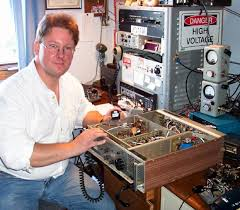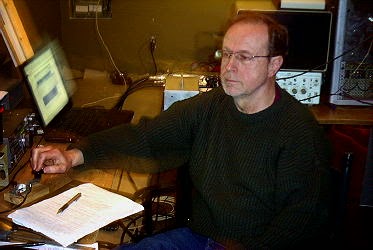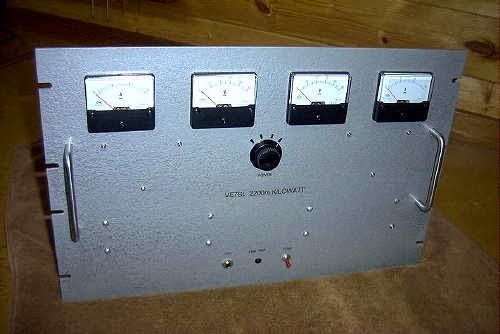Posts Tagged ‘CW’
 CW Op’s Mini-CWT Contest – Results!
CW Op’s Mini-CWT Contest – Results!
 |
| Map of Stations Worked in the Mini-CWT |
Every Wednesday the CW Operators Club has a mini contest called the MINI-CWT. It runs for one hour – 10:00 pm to 11:00 pm local time here in Kansas. This time works great for me – kids are in bed, and house chores are complete!
This is the second time I have operated this contest and I had a blast. Conditions on 20 meters were awful here – I didn’t hear one signal on the band except some digital signals. So I immediately went to 40 meters and stayed there for the duration.
All told I worked 20 stations, for a score of 400 points- all stateside with one except being Canada. I was really happy with this result!
When I worked the June contest I only worked 6 stations for a total score of 36 points, so I greatly improved tonight!
You can see a map of the locations of the stations I worked during the contest last night. I created this using a site that I found that is really cool. It is QSOMap.org – and it lets you upload an ADIF file and it maps the locations.
I really enjoy working contests. Running QRP it gives you the opportunity to work some really good operators that also have excellent antennas. Everyone I called last night, I worked!
Thanks to all the ops that pulled my signal out – you made it a fun night!
Also be sure and check out my N0HYD YouTube Channel!
 Not often
Not often
that I link to an article written for eHam, but here’s a really good one written by Ron KA3J:
http://www.eham.net/articles/32380
It regards Technicians (or any new Hams for that matter, CW and QRP – relevant topics for this blog!) And just to let you know how good it is, up to this point in time, Ron has not been heckled in the commbox!
72 de Larry W2LJ
QRP- When you care to send the very least!
 QRP 1,000 Miles per Watt….from the Campground
QRP 1,000 Miles per Watt….from the Campground
 |
| KX3 bathed in light from my red headlamp |
The kids are starting back to school this week, so we thought we would get in one more family outing before life gets crazy. So last week we went camping from Wednesday morning until Saturday morning. Its great to be at the campground during the week – almost nobody else is there!
It rained every night – the days were hot and humid. We spent most afternoons out on the lake in my Dads boat he loaned to use – nice and cool with lots of swimming and tubing.
Friday night I had time to play radio! I setup the KX3 running on internal batteries on the picnic table. Hooked up the portable QRP antenna that I lashed up to the canopy and I was off to the races.
I used my headlamp with a red light to see what I was writing and the radio controls. This worked exceptionally well – and kept the bugs away. I have used the white light before and it really draws in the bugs!
When I turned the rig on it was on 20 meters – I expected it to be dead since it was about 03:45 UTC (10:45 PM local) – but I immediately heard signals. As I tuned around, I was hearing DX everywhere!
I listened to some of the exchanges, and could tell it was a contest – RST and Serial was the exchange. Turns out it was the Worked All Europe HF Contest.
So I dove into the mix and started pouncing! Wow it was fun….
UA7K – Russia (I think, could not find in QRZ)
UW2M – Ukraine (1,172 miles per watt)
UT0U – Ukraine (1, 134 miles per watt)
AI6O – California
K1XM – Massachusetts
UY5ZZ – Ukraine (1,115 miles per watt)
RW1A – Russia (1,091 miles per watt)
RM5D – Russia (1,091 miles per watt)
YP9W – Romania (1,139 miles per watt)
HA8VV – Germany (1,055 miles per watt)
S57DX – Slovenia (1,054 miles per watt)
HG7T – Hungary (1,091 miles per watt)
HG8R – Hungary (1,115 miles per watt)
DJ5MW – Germany (1,004 miles per watt)
SN6A – Poland (1,019 miles per watt)
I finally shut it down at 05:21 (12:21 AM local time) – but the band was still hoping. I did tune around 40 meters and heard some signals, but the antenna just needs to be longer for good 40 meter operation.
What a blast! Almost everyone came back to me on the first call – only 3 times did I have to repeat my call. Everyone I called, I worked!
It was fascinating to think about working Russia and Ukraine with all the tensions in that part of the world right now – guys are still having fun playing with the radio.
I am really enjoying dipping my toe into these contests – it is a great way to work a bunch of stations – and some DX to boot.
 |
| Nick KE0ATH working 2 meters |
Nick (KE0ATH) also did some operating on 2 meters using a collapsible portable J-pole that we built together. He had a blast. He is working on putting together a go-box 2 meter station for camping and outdoor adventures.
Be sure and check out, and subscribe to my YouTube channel – I am working on several more videos – stay tuned!
 Special 630m Activity Night This Fall
Special 630m Activity Night This Fall
"Special Event Planned this Fall on 630 Meters
Experimental operators on 600/630 meters will conduct a special event operation October 31-November 2. The Maritime Radio Historical Society (MRHS), which maintains the KPH/KSM commercial coast stations, will take part in the event.
“This event marks the 106th anniversary of the Berlin Treaty that created the international distress frequency at 500 kHz,” said ARRL 600 Meter Experimental Group Coordinator Fritz Raab, W1FR. “This will be a CW event.”
Raab said some stations will operate beacons on the experimental band, transmitting anniversary messages, while others will simulate the sort of maritime communication that once occurred in this part of the medium-wave spectrum. They will call CQ on a designated calling frequency and then change frequency to complete the contact. Silent periods will be observed.
The activity will occur between 465 and 480 kHz and between 495 and 510 kHz. “Different licensees have different frequency authorizations,” Raab noted. “The designated calling frequencies are 475 kHz for the lower band, and 500 kHz for the upper band.”
Raab noted that this may be the last such event that includes operations on 500 kHz itself. “This band is not being included on new experimental licenses, as it is supposedly reserved for a new maritime-data service,” he explained. He said he anticipates that more information will be released as the event draws closer. "
Not seeing any mention for Canadian activities in the event, I contacted the organizer and ARRL 600m Experimental Group Coordinator, Fritz Raab (W1FR). I asked Fritz if it would be possible for the three active Canadian 630m stations (VE7BDQ, VO1NA and myself) to 'officially' become part of the planned activities. I suggested to Fritz that the three of us could offer the chance for amateurs in both Canada and the U.S. to actively communicate with some of the 630m Canadian stations by working in the 'crossband' mode. Each of the three stations would have their own assigned transmit frequency and, following CQ's, would listen on specified HF frequencies for any answering stations. Fritz was delighted to add us to the program and the next '630 m Activity Night' announcement will include all of the details including exact frequencies.
 | |||
| Joe - VO1NA |
VO1NA will be transmitting from Torbay, Newfoundland and should be very well heard throughout eastern North America. Joe will be listening for replies on both 80 and 40m CW.
 |
| John - VE7BDQ working 2200m - 160m crossband at VA7LF |
VE7BDQ will be transmitting from Delta, B.C., south of Vancouver. John will be listening for callers on 80m CW only. Being a retired Canadian Coast Guard RO, John has many years of experience manning the 500kHz watch when 600m maritime activity was in its prime.
VE7SL will be transmitting from Mayne Island B.C., midway between Vancouver and Victoria, on Vancouver Island. Like Joe, I plan to listen for callers on both 80 and 40m CW.
 |
| VE7SL - 2200m / 630m TX |
All three Canadian stations are able to muster the maximum allowed eirp for 630m and with the improved propagation of late October, the opportunity for some interesting crossband contacts should be realized on both ends of the continent.
There will be more details well before the event but hopefully you can become part of the fun by giving some of the crossbanders a call on their HF 'QSX' frequencies....and if you know of anyone that might like to participate, please let them know about the upcoming event as, like so many on-the-air activities, the more the merrier!
 QRP Works – QRO Works Better
QRP Works – QRO Works Better
For more than a decade, beginning in 1996, I adopted the QRP lifestyle and had more fun building kits, learning about antennas, making friends and filling the log than I had during any other period of my many decades in the hobby. Granted, my goals during that period were modest, but I’ve never had much problem making contacts using QRP and CW with wire antennas.
Count me as a believer in the magic of QRP. But while contacts can be made using QRP, that doesn’t mean it’s always easy for the guy on the other end of the link, who may struggle mightily just so I could put him in the log and publicly proclaim, “QRP Works!” Low-power enthusiasts should always acknowledge that any success is not so much theirs as it is the guy on the other end of the contact.
Beyond that, admitting that there are benefits to be derived from generating a potent signal is important because they are many. You don’t read much about that in the posts of QRP blogs. Most seem to take great pleasure in pointing out that “QRP works” without mentioning the obvious — if low power CW works then high power CW works too.
This last weekend, John Shannon, K3WWP, a devoted QRP and CW enthusiast and co-founder of the North American QRP CW Club (NAQCC) surpassed the 20 year point in a continuing “streak” of days (7,305) making at least one CW contact. Using low-power and simple wire antennas. From a less than desirable HF radio location. It’s an impressive show of perseverance and tenacity that he says was done to show that QRP CW works. He wrote:
“This is dedicated to all those who say things like ‘You need high power, big antennas, and a great location to be able to make ham radio contacts’, or ‘Life is too short for QRP’, or ‘CW is dead’ and other such remarks denigrating QRP/CW.”
But I would suggest that there are fewer operators who claim “QRP doesn’t work”, than there are QRP enthusiasts willing to concede that finding a potent signal that pops out of the noise floor is one of the great joys of abiding in the shortwaves.
The “right tool for the right job” is an eternal wisdom. It’s always been good advice. “If all you have is a hammer, every problem begins to look like a nail” is another nugget of wisdom. Putting them together and stretching them to fit, I came up with a corollary:
If all you want to use is QRP, you’ll spend your life preaching how well it works.
Common sense, and physics, support the notion that if a five watt CW signal can be copied, a 1,000 watt signal will be easier to copy despite the vagaries of propagation, QRN, and QRM — though you won’t find that truism bandied about much.
QRP Works – QRO Works Better.
I’m going to have that tee-shirt made. Who wants one?
 IARU HF World Championship 2014 Results
IARU HF World Championship 2014 Results
 |
| Click to Enlarge – I am towards the bottom! |
A couple weeks ago the IARU HF World Championship 2014 was held. It started at 7:00 AM local time on Saturday morning and ended 7:00 AM local time on Sunday morning.
I have been wanting to work a big contest, and I was able to squeeze a few hours of “shack time” into my schedule on Saturday.
I hit the ground running on Saturday morning right when the contest started. I did a bit of band hopping for the next 90 minutes. Then I was able to get back on about 3:00 pm local for an hour, then back on again about 11:00 pm local for an hour or so.
I worked 55 stations during this limited operating time. I worked mostly stateside stations, but I was able to pick up a couple DX contacts as well.
The only HQ station I worked was W100AW – which was a thrill. I also worked stations in Canada, Bermuda, Europe, Jamaica and Brazil. I also worked Hawaii several times, which I had never done before.
Here is the breakdown per band:
40 Meters: 34 Contacts
20 Meters: 5 Contacts
15 Meters: 15 Contacts (This would have been more productive if I had more time in the afternoon)
10 Meters: 1 Contact
The good news about my high noise level at the QTH is that if I can hear them, I can almost surely work them. I think I only called 2 people that I did not end up working.
I operated “search and pounce” the entire contest. Starting at one end of the band and working my way to the other end. One thing I found interesting is that I would finish scanning from end to end, then start over. On the next pass I would hear stations I didn’t hear on the first past. Very interesting!
The other thing I was happy to see is that I was not last! I uploaded my scores to 3830scores.com and as you can see in the image above, I was not last.
I will officially submit my score to the contest, just to eventually see my call sign in print.
This was very fun! I know I will never by a big gun contest station, but contests are a great way to improve your CW speed, operating skills, and have lots of fun!
 Long Shadows of Summer
Long Shadows of Summer
When I got home from work last night I quickly mowed the lawn because the weatherman said there was a sixty percent chance of rain on Saturday and Sunday and I wanted to get ahead of the game. After working in the yard I plopped down in the shack to see if I couldn’t make quick work of the W1AW/1 and W1AW/9 portable stations.
Worked them both within a whisker of each other on 40 meter CW then worked them both again later on 80 meter CW for insurance. I didn’t think the Indiana station would be difficult, but I wasn’t quite as confident about Rhode Island but all’s well that ends well and both are logged and another week of the QSO Party is behind us.
Given that the weatherman said it would probably rain, I shouldn’t have been surprised to wake up this morning to sunshine and blue skies. I swear the weather prognosticators are getting worse at their jobs even as technology has delivered into their hands unfair advantage over the elements.
Brenda says it’s because the weather has become “news” and all of them want to be the first to report a bad storm using giant touch-screens powered by super, frappa, chappa, slappa doomsday doppler radar systems.
She might be right…
Anyway, with the sun shining we hit the local farmers market early this morning and picked up more sweet corn, tomatoes, and a great big melon. And get this, the guy who was selling from the back of his melon truck, told everyone who would listen that he would be back in two weeks — with apples.
Yep, the days are ticking away and the orchards around here are near to busting with autumn goodies. Another cold snap is due to arrive here on Monday and it looks like the first few nights of August could break a few records.
Not to worry though, I’m certain there remains yet a few more days of blistering heat before Summer yields to Fall, but we’re on the backside of 2014 with school days and sweet apple cider coming up fast.
Filed under: Ham Radio, Life Tagged: cw, hr, qso














